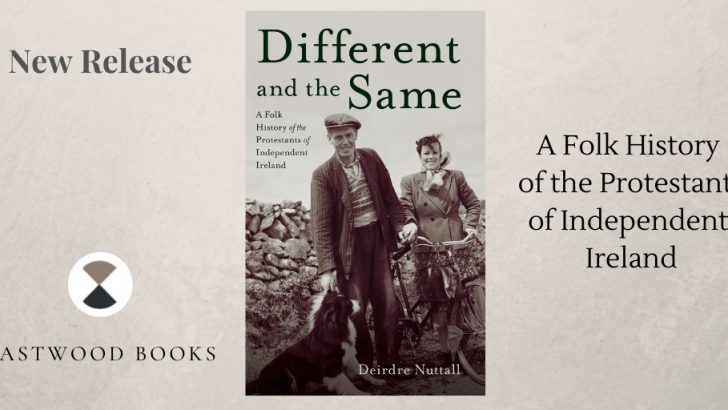Different and the same: a folk history of the Protestants of independent Ireland
Deirdre Nuttall (Eastwood Books/Wordwell, €25)
Ian d’Alton
This illuminating book is about “the stories of the ‘old’ Protestant communities of independent Ireland and how these stories have justified feelings of belonging, entitlement, estrangement, marginalisation, and more in the context of a State that they have sometimes historically perceived as hostile, or at least indifferent, to their interests”.
The evidence here would strongly suggest that while assimilation and integration has been accepted by the Protestant community generally, the journey has been anything but smooth for many, and still not over for some. The book is primarily a cultural, not faith-based, exploration of those who weren’t in the elite Protestant groups. While these are stories and histories specific to southern Irish Protestants, there are many aspects which could equally be applied to southern Catholics. Marginalisation, economic and social deprivation, feeling different were by no means a Protestant preserve.
Background
The author has a background in folklore, archaeology, social anthropology and ethnology, and thus has a valuable grounding in categorising and characterising social and cultural communities such as this. Ms Nuttall examines narratives and remembrances of origin, the past, identity, loyalty and culture, love and marriage, feelings of difference and sameness, land and landscape, of rural and urban.
The idea emerged from the absence of Protestant contributions to the collections assembled by the Irish Folklore Institute and the Irish Folklore Commission in the 1930s.
That absence did not originate in any sectarian bias per se, but was largely the consequence of the emphasis on collecting stories from those of a rural and Gaelic background– the “noble Catholic peasantry”, as Ms Nuttall describes them.
Her source material was principally, though not exclusively, a series of 98 interviews and 76 responses to questionnaires that were generated by letters placed in The Irish Times, the Irish Independent, regional newspapers, the Irish Farmers’ Journal – but not the Church of Ireland Gazette, as she didn’t want to skew towards the most religiously-observant people.
She also followed interviews in the broadcast media that emphasised the desire to hear the stories of ordinary ‘small house’ Protestants. Most respondents were over 70 years of age.
The author is acutely conscious that “All these stories are subjective; they are not an objective historical record of the recent past, and they may not be reflective of everyone’s experience”. This is a wise caveat – the feelings of alienation and nostalgia for a ‘loyal’ past often articulated by the respondents in this study would not, for instance, have been as evident in this reviewer’s household (Church of Ireland, 1950s and 1960s Dublin and Cork, middle-class). His family felt more the ‘same’ than ‘different’.
Throughout, context is interwoven through the stories that Ms Nuttall details; this is one of its many strengths and attractive features. The Introduction is a model of its kind, a balanced and informative account of what constitutes a ‘Protestant’; the effect of demographic changes; and whether Protestants really do constitute a distinctive and delineated cultural group.
This well-written book captures a sense of people-hood and distinctiveness that, though, appears to be on the way out – Ms Nuttall writes that “It is hard to avoid the conclusion that the story of the Protestants of independent Ireland as a cultural, if not a religious, minority is drawing to a close”.
That’s quite sobering, if true. What does it say to northern Protestants and the chances of their traditions being treasured and surviving in an all-island entity?



